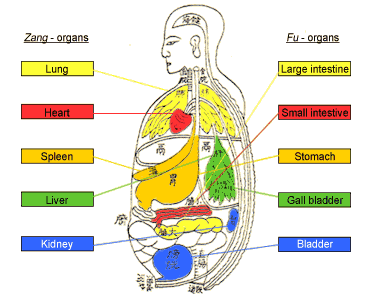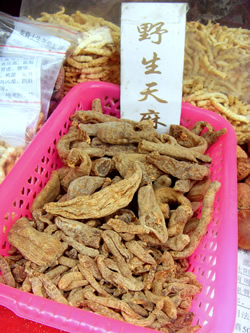Chinese Medicine Guideline for Hypertension Management
From a traditional Chinese medicine (TCM) viewpoint, hypertension is an abnormal body sign, indicating an under-regulated state of the body due to multiple influences. TCM believes a sedentary lifestyle, persistent stress, unhealthy diet, organ damages, and constitutional defects are all contributed to the raised blood pressure. Inside the body, damages in heart, liver and kidney systems are often happened, there may also have dysfunctions of the Thoroughfare Vessel (chong mai) and Girdling Vessel (dai mai) among women. Clinically, individuals can appear a variety of disharmony patterns, below are some commonly seen in different stages of hypertension:
 |
|
- Early stage hypertension: the body tends to be hyper-functioning (excess syndromes), and may present with patterns such as liver yang hyperactive, qi stagnation and blood stasis, or phlegm and dampness accumulation;
- Middle stage hypertension: the body begins to weaken, and may present with patterns such as qi deficiency with blood stasis, yin deficiency and yang hyperactive, or qi deficiency and phlegm obstruction;
- Late stage hypertension: the body is weakened (deficient syndromes) and stagnations often develop, that may present with patterns such as yin deficiencies of liver and kidney, qi deficiency and fire depletion of vital gate.
TCM management for hypertension focuses on integrated regulating the body, physicians not only aim to lower blood pressure, but also relieve unpleasant symptoms, improve body functioning, and protect target organs like the heart, brain and kidneys. This can resume the body’s self-regulation and ensure a better life quality of individuals.
In regarding to the above, TCM principles for reducing blood pressure are:
- Eliminating dampness and resolving phlegm: this promotes excess body fluids and wastes to eliminate through urination. The action also lowers blood lipids, and promotes blood flow throughout the body. Some commonly used herbs are corn silk, plantain seed, largehead atractylodes rhizome, poria, oriental water-plantain rhizome, and morinda root. The herbs usually act as the major ingredients for mild hypertension, they are also used for coordinating or enhancing the overall therapeutic effects in moderate to severe hypertension.
- Activating blood and resolving stasis: This can expand blood vessels, free blood circulation, also soothe the central nerve system, slow down heartbeat, and inhibit blood platelets clotting. Some commonly used herbs are red sage root, Sichuan lovage rhizome, motherwort herb, Chinese safflower, peach kernel, hawthorn fruit and notoginseng.
- Soothing liver and extinguishing wind: This can calm down and regulate the nervous system, expand blood vessels, promote urination, and regulate calcium metabolism. Commonly used ingredients are gambir vine stem, tall gastrodia tuber, abalone shell, chrysanthemum, selfheal fruit spike, white peony root, fossil bone, oyster shell, nacre, and magnetite. The herbs are very effective in relieving symptoms related to hypertension.
 |
|
 |
|
 |
Gambir vine stem |
|
Tall gastrodia tuber |
|
Abalone shell |
- Clearing heat and purging fire: This can expand blood vessels, promote excretions, and calm down the body. Commonly used herbs are Chinese gentian root, baical skullcap root, golden thread rhizome, wild chrysanthemum, selfheal fruit spike, figwort root, pagoda tree flower, radish seeds, feather cockscomb seed, cassia seed, and peony bark.
- Nourishment and reinforcement: From a yin and yang balance viewpoint, most hypertension individuals tend to be excess in yang, and deficient in yin inside the body. Thus nourishing and enriching the yin aspects of the body is essential, suitable ingredients include sour jujube seed, fleeceflower root, white peony root, asparagus root, coastal glehnia root, fragrant Solomonseal rhizome, glossy privet fruit, and processed rhemannia rhizome, which are beneficial for promoting the self-regulation of the body. In addition, when the condition has treated and is under control, it is advised to keep nourishing and fortifying the liver and kidney on a regular basis, with tonics like wolfberry fruit, fleeceflower root, mulberry mistletoe, cistanche, achyranthes root, glossy privet fruit, and processed rhemannia rhizome, black sesame, mulberry, walnut, caterpillar fungus and eucommia bark, which help consolidate the treatment results and stabilize the blood pressure.
Generally, TCM methods for hypertension are not as quick and steady as conventional methods, but TCM methods have fewer adverse effects, and also the advantages in improving hypertension related symptoms, as well as reducing the risk of complication development. Since Chinese medicine focuses on holistic healthcare, in many instances, integrated treatment methods by using both Chinese and western medicine have had more favorable outcomes then using either alone. TCM methods can be incorporated as part of the hypertension management, and may even be the first line therapies for mild to moderate cases. |